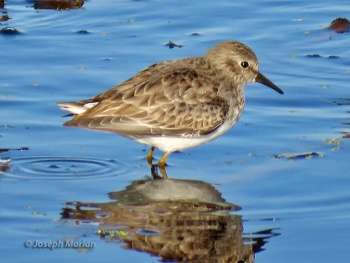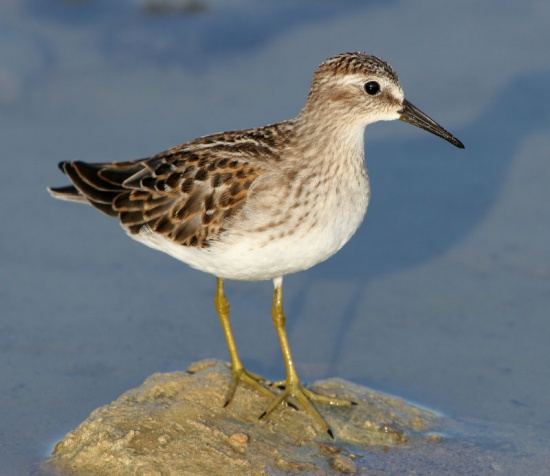- Calidris minutilla
Identification

Photo © by Joseph Morlan
Staten Island, San Joaquin County, California, USA, 23 November 2019
13–15 cm (5-6 in)
In most of its range, it is the only peep with yellow legs, but note distinction from Long-toed Stint below. Least Sandpiper has short thin dark bill, brown with dark brown streaks on top and white underneath. Light line above the eye and a dark crown.
Similar Species
Semipalmated Sandpiper is plump compact looking, more white to throat, has slightly heavier black legs, and semipalmations between toes.
Western Sandpiper is lanky looking, has black legs, and semipalmations between toes. In Breeding plumage is heavily spotted on belly and is grayish withrufous on crown, auriculars, and scapulars.
Long-toed Stint has a different lore pattern with a white teardrop shaped extension forward of the supercilium which loops down in front of the eye, ending before the bill. Long-toed also has a vertical dark mark in front of the eye and a thin sub-loral loop which together form a sideways "J" mark in all plumages. Least has a straight lore stripe. In juvenile plumage Least Sandpiper has buffy fringes to median coverts while Long-toed has these feathers white edged (lower scapulars are white tipped on both). Split supercilium often claimed as a feature of Long-toed Stint is not reliable.
Distribution
United States and northern South America: breeds northern North America; winters to southern South America and Hawaiian Islands.
Taxonomy
Formerly placed in genus Erolia. In past, sometimes considered conspecific with Long-toed Stint.
Subspecies
This is a monotypic species[1].
Habitat
Tundra or in bogs. In migration found at mud flats, beachs, sod farms, etc.
Behaviour
Often in crouched position with knees very bent, feet planted forward (so far many times that they can appear to be feeding between their toes) and with belly much closer to ground than other peeps2. Usually found on shore instead of wading.
Breeding
The 4 eggs are laid in a shallow scrape on the ground, lined with grass and most. Both parents incubate.
Diet
These birds forage on mudflats; their diet includes small crustaceans, insects and snails.
Vocalisations
Typical flight call is a high-pitched slightly rolled kree-eeet. Other calls and songs during breeding season.
Movements
Migratory. Moves in broad front over interior North America to Southern USA, Greater Antilles, Gulf of Mexico, Middle America and northern South America.
References
- Clements, J. F., T. S. Schulenberg, M. J. Iliff, S. M. Billerman, T. A. Fredericks, B. L. Sullivan, and C. L. Wood. 2019. The eBird/Clements Checklist of Birds of the World: v2019. Downloaded from http://www.birds.cornell.edu/clementschecklist/download/
- Cox, Cameron. North American Peeps: A Different Look at an Old Problem (http://surfbirds.com/Features/coxpeeps1006/coxpeeps1006.html).
- The Website of Everything
- Chandler, R. (2009). Shorebirds of North America, Europe, and Asia: A photographic guide. Princeton.
- Nebel, S. and J. M. Cooper (2008). Least Sandpiper (Calidris minutilla), version 2.0. In The Birds of North America (A. F. Poole, Editor). Cornell Lab of Ornithology, Ithaca, NY, USA. https://doi.org/10.2173/bna.115
- Van Gils, J., Wiersma, P. & Kirwan, G.M. (2020). Least Sandpiper (Calidris minutilla). In: del Hoyo, J., Elliott, A., Sargatal, J., Christie, D.A. & de Juana, E. (eds.). Handbook of the Birds of the World Alive. Lynx Edicions, Barcelona. (retrieved from https://www.hbw.com/node/53930 on 1 March 2020).
Recommended Citation
- BirdForum Opus contributors. (2025) Least Sandpiper. In: BirdForum, the forum for wild birds and birding. Retrieved 11 May 2025 from https://www.birdforum.net/opus/Least_Sandpiper
External Links
GSearch checked for 2020 platform.1





